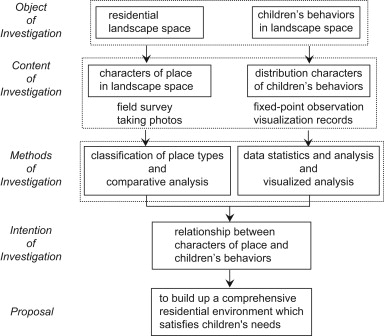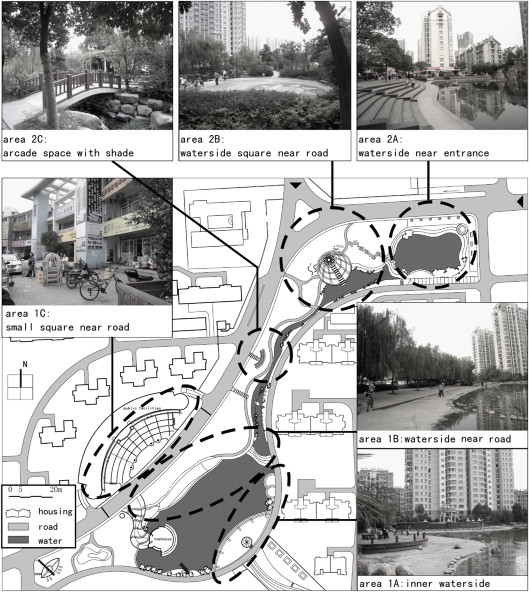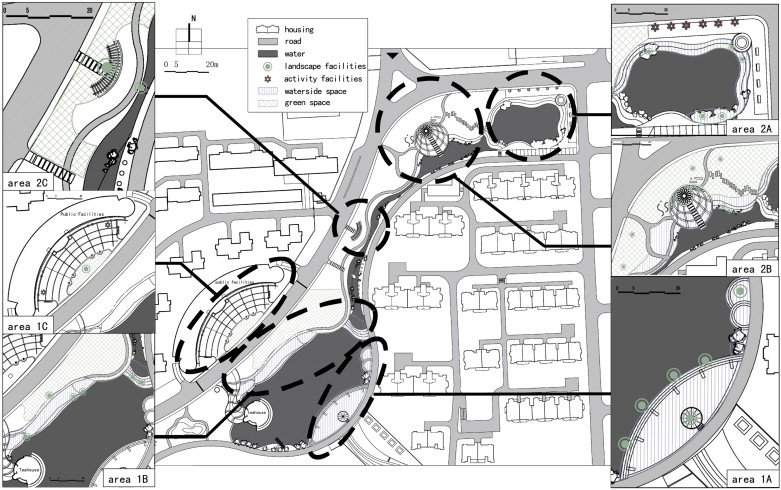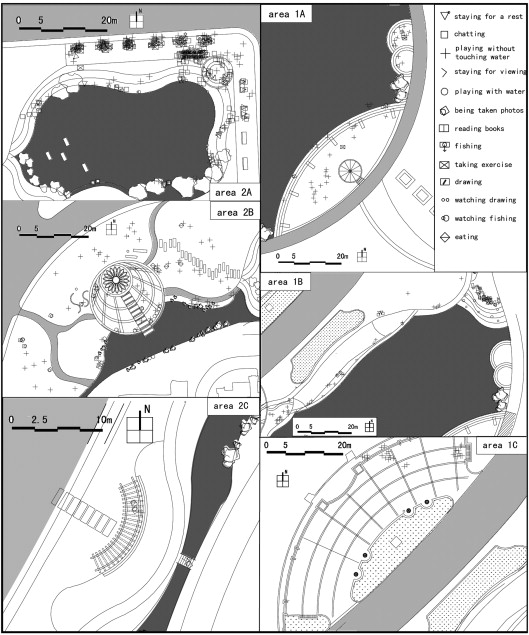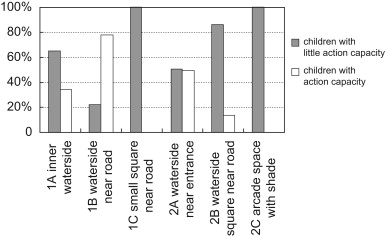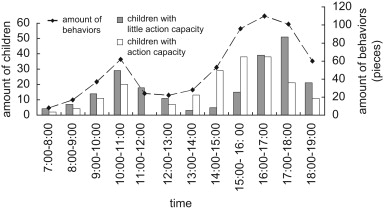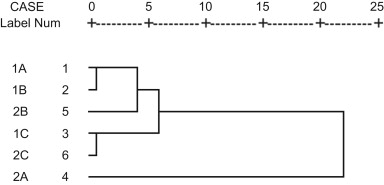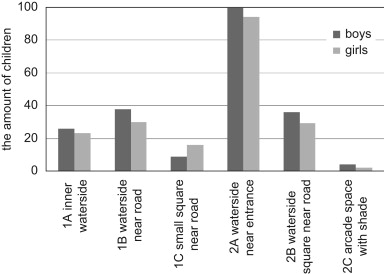Abstract
This paper reviewed child behavior in Chinese residential landscapes. A field survey was used to investigate place characteristics, whereas fixed-point observation and visualization records were utilized to analyze child behavior. Children were then classified into two categories, namely, those with action capacity and those with little capacity. Based on the classification and comparative analysis of place characteristics, along with the quantitative and visualized analysis of child behavior, the relationship between these two aspects was determined, and the effect of spatial elements in the selected residential areas on such a relationship was clarified. Additionally, the designing of a comprehensive landscape space that satisfies childrens needs was also discussed. The conclusions are as follows: (1) Waterside is the element that most significantly affects child behavior. Children who can act on their own prefer to play along the waterside. (2) Open spaces attract children with action capacity, whereas children with little capacity tend to choose more private spaces. (3) Despite the presence of facilities for various activities, an extremely open space or one that is separated by a road still affects child behavior. (4) A comprehensive space with a water landscape, fitness facilities, high accessibility, and a number of cultural events may significantly affect child behavior. Both types of children were found to enjoy a place with such characteristics. Therefore, the evaluation of residential landscape space should be integrated with landscape design.
Keywords
Place characteristics ; Child behavior ; Action capacity ; Relationship ; Residential landscape spaces
1. Introduction
1.1. Current situation of landscape space in Chinese residential quarters
With the recent development of the Chinese economy and acceleration of the urbanization process, an increasing number of urban residential quarters have been built rapidly. However, increasing competition and financial benefits have driven a large number of modern developers and designers to construct residential environments without considering the residents' behavioral characteristics and psychological needs. Such a condition reduced the rate of residential landscape utilization to the extent that landscape facilities are left unused.
Children, considered to be the future and hope of human beings, are the most vulnerable social group. In contemporary urban life, landscape spaces in residential quarters have increasingly played a significant role in childrens growth, apart from school and family. Approximately 86% of parents were found to have the desire to have their children play within the residential area (Yunbo, 2010 ). A number of foreign scholars also found that the influence of a peer group on children surpasses that of the school and family. Communication with peers has become an import means for sharing information. Therefore, child behavior and psychological characteristics should obviously be considered in residential environment design. Thus, this study was undertaken in an attempt to investigate child behavior in a residential landscape space through a case study based.
1.2. Objectives
This research attempts to understand child behavior in response to their corresponding landscape space. Specifically, the effect of spatial elements in the selected residential areas on child behavior is clarified, and the process by which to create a comprehensive residential environment that satisfies childrens needs is explained (Fig. 1 ).
|
|
|
Fig. 1. Investigation framework. |
1.3. Previous studies
Qin (2010) studied current and common problems of childrens activity spaces in urban residential quarters in China. Qin studied the physiological, psychological, and behavioral characteristics of children of different ages and highlighted the primary requirements that should be met and questions that should be considered in designing of childrens recreation spaces. However, Qin did not provide quantitative descriptions of child behavior in a residential environment. Instead, he primarily focused on a theoretical analysis and paid little attention to the relationship between child behavior and landscape space.
Japanese researchers Yun et al. (2003) conducted a study on the mutual relationship among the ways to use a space, the specific characteristics of the place of stay, and environmental factors. Through behavior observation, the authors investigated the utilization patterns of the place of stay and other spaces using various parameters, including time and users, functions of environmental factors demanded by time and users, and additional factors, such as living things and various land surfaces that enhance the flexibility and variety of the space. Nevertheless, staying is not the only behavior exhibited by children in landscape spaces. Other behavior, such as playing, chatting, and viewing, among others, also occurred simultaneously with staying. The features of such behavior also relate closely with the space. Thus, the previous study was unable to sufficiently explain the complexity of child behavior and psychology. An examination of staying behavior is inadequate for analyzing the relationship between child behavior and place characteristics in general.
The author and colleagues (Li et al., 2006 , 2007 ) had made a study on human behavior along waterside in Chinese residential quarter, in which the object of investigation were human beings without considering the age. The current paper thus analyzed child behavior distribution in various types of residential landscape spaces based on behavior observation over a period of 12 consecutive hours. As a result, through statistics and visualization records, better understanding of the relationship between child behavior and space can be facilitated.
2. Materials and methods
2.1. Outline of investigation
Century Sunshine Garden Residential Quarter is nearly 40 ha is size and is located in Hefei, Anhui Province, at the Yangtze River Valley in East China. This residential complex was built in 1998 and remains one of the largest multifunctional quarters in southeast Hefei. The quarter offers complete public service facilities, including a junior school, primary school, kindergarten, and club, among others. Most residents have lived in this quarter over two to three generations. Although the landscape space of the residential quarter was designed by the authors (Li, 2004 ), child behavior in relation to the space can be best understood through an investigation to determine the advantages and limitations of the study space designed for children. The outline of investigation is shown in Table 1 .12
| Date | October 7, 2010 |
|---|---|
| Time | 7:00 to 19:00 |
| Weather | Cloudy-clear |
| Temperature | 15–25 °C |
| Season | Autumn |
Given that child behavior is the subject of this investigation, the children were classified into two categories based on their action capacity. One group comprised children with the ability to act on their own, whereas the other comprised those who need to be taken care of.
Children who have action capabilities are primarily those above Grade 2 (approximately seven to eight years old) in primary school and have developed behavior habits through abstract logical thinking. They do not require constant attention within the residential quarter and can decide on where and how to play by themselves. Conversely, children with little action capability are those below Grade 1 in primary school. The behavior of such children remains unstable and random. These children cannot properly act by themselves and thus, have to be supervised carefully. Given that the two groups of children have varying behavior, they should be investigated separately.
2.2. Data processing
Six areas, namely, 1A, 1B, 1C, 2A, 2B, and 2C, were chosen for observation from the central landscape of the residential quarter (Fig. 2 ). Various symbols were used to mark on plan. These symbols represent the type, quantity, location, direction, and distribution of child behavior. Moreover, the time the behavior took place and factors affecting their behavior (e.g., with parents' attention, simultaneous occurrence of behaviors different behavior types, and so on) were also recorded in data sheets.
|
|
|
Fig. 2. Distribution map of selected areas. |
3. Results
3.1. Place characteristics
To study behavior in relation to space, the spatial characteristics of each observation area should be initially be clarified (Fig. 3 ).
|
|
|
Fig. 3. Place characteristics. |
Area 1A is the inner waterside space near the footpath close to the houses. The area is an open space that can be considered as separate from the outside. A number of landscape facilities are present, including sculptures, stepping stones, a fenced-in waterside terrace, wooden seats around a tree, a Euro style pavilion, and so on. However, the pavilion has no seats, and a level difference exists between the pavilion and the surrounding footpath.
Sharing the waterside with area 1A is area 1B, which is a shallow beach near the main road. Area 1B has a teahouse that is isolated from the road by a large, green area. Beside the teahouse is a footpath that goes through the whole space. Area 1B is therefore a semi-open space with high accessibility and a relatively quiet environment. A walking path above the water and the large stones along the waterside are the landscape facilities that stand out in this area.
Area 1C is a small fusiform square separated by the main road from area 1B. The range of green space is small, encompassing inaccessible grass and trees along the road. Despite the presence of playing facilities such as a childrens slide, this area is primarily used as an entrance square for public facilities, including a vehicle repair shop, an infant school, and a supermarket. Area 1C is another open space with entrances to the underground garage.
Area 2A, which is located at the intersection of two main roads, is the waterside open space near the main entrance and public business facilities. As the gateway to the whole central landscape system, the area has a wide waterside terrace, landscape facilities such as rockeries, stones, and seats, as well as fitness facilities. Area 2A can therefore be described as a compound square.
Close to area 2A, area 2B is a round square surrounded by a grassy slope. This quiet semi-open space is divided by a footpath, with the southeast part being the waterside terrace and the left part being a grassy space with a semicircle square having wooden seats.
Area 2C is a relatively private shady space. The most obvious feature of this area is the arcade for resting. This area is opposite to a wooden bridge, and across the water is the shallow beach of area 1B, which one can reach by walking along the arcade.
3.2. Distribution characteristics of child behavior in space
According to the attributes, behavior can generally classified into two, namely, dynamic and static behavior. Considering the characteristics of children, their behavior can be classified into four categories, namely, [playing], [resting], [viewing], and [others]. Based on the occurrence frequency of each behavior (Table 2 ), [playing] (recorded 455 times) had the highest occurrence frequency and was thus identified as the dominant behavior. The frequency of [resting] (recorded 136 times) was the second highest, whereas those of [viewing] and [others] (recorded 28 times and once, respectively) were significantly lower. This finding may relate closely to the activeness of children.
| Playing | Resting | Viewing | Others | ||||||||||||||
|---|---|---|---|---|---|---|---|---|---|---|---|---|---|---|---|---|---|
| Playing without touching the water | Playing with water | Exercising | Fishing | Being taken photos | Drawing | Sitting | Chatting | Viewing the scenery | Watching fishing | Watching drawing | Eating | Reading | |||||
| Viewing areas | Occurrence frequency | Proportion | Occurrence frequency | Proportion | Occurrence frequency | Proportion | Occurrence frequency | Proportion | |||||||||
| 1A inner waterside | 42 | 2 | 2 | 0 | 1 | 0 | 2 | 3 | 0 | 0 | 0 | 0 | 0 | ||||
| 47 | 0.1 | 5 | 0.4 | 0 | 0 | 0 | 0 | ||||||||||
| 1B waterside near road | 53 | 10 | 0 | 0 | 7 | 0 | 2 | 5 | 3 | 0 | 0 | 0 | 0 | ||||
| 70 | 0.15 | 7 | 0.05 | 3 | 0.11 | 0 | 0 | ||||||||||
| 1C small square near road | 23 | 0 | 0 | 0 | 0 | 0 | 0 | 2 | 0 | 0 | 0 | 0 | 0 | ||||
| 23 | 0.05 | 2 | 0.01 | 0 | 0 | 0 | 0 | ||||||||||
| 2A waterside near entrance | 113 | 12 | 36 | 0 | 0 | 62 | 26 | 91 | 1 | 4 | 15 | 1 | 1 | ||||
| 223 | 0.49 | 117 | 0.86 | 20 | 0.71 | 2 | 0.25 | ||||||||||
| 2B waterside square near road | 63 | 15 | 0 | 1 | 9 | 0 | 2 | 3 | 1 | 2 | 0 | 6 | 0 | ||||
| 88 | 0.19 | 5 | 0.04 | 3 | 0.11 | 6 | 0.75 | ||||||||||
| 2C shady arcade space | 2 | 0 | 0 | 0 | 2 | 0 | 0 | 0 | 2 | 0 | 0 | 0 | 0 | ||||
| 4 | 0.01 | 0 | 0 | 2 | 0.07 | 0 | 0 | ||||||||||
| total | 296 | 39 | 38 | 1 | 19 | 62 | 32 | 104 | 7 | 6 | 15 | 7 | 1 | ||||
| 455 | 1 | 136 | 1 | 28 | 1 | 8 | 1 | ||||||||||
Counting Unit: Observed occurrence frequency.
For [playing] behavior, which had the highest frequency, almost half of the recorded instances occurred along the waterside near the entrance (area 2A). The proportions of the behavior types were relatively lower along the waterside square near the road (area 2B) (approximately 19%), waterside near the road (area 1B) (approximately 15%), and inner waterside (area 1A) (approximately 10%). The behavior types seldom occurred in the small square near the road (area 1C) (approximately 5%) and in the shady arcade space (area 2C) (approximately 1%). As a result, the waterside near the entrance (area 2A) was found to be more conducive to [playing] behavior than any other place, whereas the small square near the road (area 1C) and the shady arcade space (area 2C) may play insignificant roles.
For [resting] behavior, recorded instances also occurred most frequently along the waterside near the entrance (area 2A) (approximately 86%), but frequencies less than 5% were observed along the inner waterside (area 1A), the waterside the near road (area 1B), the small square near the road (area 1C), and the waterside square near the road (area 2B). This behavior type almost never occurred in the shady arcade (area 2C). Another static behavior, [viewing], was mostly observed in area 2A (approximately 71%). This behavior seldom occurred in areas 1B, 2B, and 2C, and never occurred in areas 1A and 1C. Consequently, childrens static behavior types were observed to have an obvious tendency to occur along the waterside near the entrance (area 2A).
For [others], including eating and reading, the subjectivity of each child may play an important role in choosing the area. Data were more random and occurrence frequency was relatively low for this behavior type. Thus, these data will not be discussed.
According to the statistics (Table 2 ; Table 3 ) and visualization records (Fig. 4 ), the distribution characteristics of child behavior in each category significantly varied from one area to another. Based on the investigation, the amount, type, density, and distribution situation of each behavior type in each space could be determined (Table 3 and Fig. 4 ). For the type and amount of child behavior in general, playing without touching the water was obviously the most evident behavior, followed by chatting. Sitting, playing with water, exercising, and drawing were observed in an average number of instances, whereas viewing, taking photos, watching those who are drawing, and eating were identified to be uncommon.
| Viewing areas | Amount of behavior (instances) | Amount of behavior types | Behavior density (instances/m2 )(a) | Distribution shape |
|---|---|---|---|---|
| 1A inner waterside | 52 | 6 | 0.08 | Ribbon+splashes |
| 1B waterside near road | 80 | 6 | 0.08 | Ribbon+splashes |
| 1C small square near road | 25 | 2 | 0.02 | Clusters |
| 2A waterside near entrance | 362 | 11 | 0.37 | Ribbon+clusters+splashes |
| 2B waterside square near road | 102 | 9 | 0.07 | Ribbon+splashes |
| 2C shady arcade space | 6 | 3 | 0.03 | Splashes |
(a) Behavior density (instances/m2 )=amount of behavior (instances)/the area where the behavior occurred (m2 ).
|
|
|
Fig. 4. Visualization records of child behavior. |
As shown above, the most number of instances of different behavior types occurred in area 2A, which accounted for a large proportion of the total (Table 3 ). Various behavior types were also observed in area 2A, where behavior density reached the highest at 0.37 (instances/m2 ). Moreover, visualization records show that drawing and exercising behavior types occurred in area 2A, showing a cluster distribution. Thus, a large amount of drawing can be concluded to relate closely with well-organized cultural activities during festivals and holidays. In addition, exercising behavior may be strongly affected by the fitness facilities in the area. Almost all instances of playing with water occurred in areas 1B, 1C, and 2B. Instances of taking photos were distributed in areas 1B, 2B, and 2C, whereas eating primarily occurred in area 2B.
A certain relationship may exist between density and distribution shape of a certain behavior. Given that the place with the most intensive behavior was area 2A, the area also exhibited multiple distribution shapes for different behavior types. The distribution shapes include clusters, ribbons, and splashes. However, in areas with lower density, the behavior types were primarily distributed in two forms, namely, ribbons and splashes, whereas in areas with the lowest density, only one kind of shape was observed (clusters in area 1C, and splashes in area 2C).
According to the statistics and visualization records, the percentage of images of each type of behavior in each area (Fig. 5 ) was determine for an analysis of the distribution of different behavior types.3
|
|
|
Fig. 5. Proportion of the two groups of children in each area. |
First, compared with children who act on their own, those with little action capability accounted for almost 100% of instances in areas 1C, 2B, and 2C. Clearly, such areas are more attractive to children who need supervision. Second, the percentage of children with little action ability in area 1A was approximately 70%, indicating that the space in area 1A also appeals, to a certain extent, to children who can act on their own. Third, the proportion of the two groups of children in area 2A was equal, showing that area 2A equally attracts both groups. Moreover, area 1B, the waterside space near the main road, was the only area wherein the proportion of children with action capability exceeded that of the other group. Area 1B is most attractive to children who act on their own.
3.3. Distribution characteristics of childrens behavior in time
Considering each hour as a period of time, the image based on the data collected from six areas at different periods from 7:00 to 19:00 is shown in Fig. 6 . This figure reflects the changes in the number of children and their behavior at different periods.
|
|
|
Fig. 6. Behavior–time Image. |
The number of children clearly changed in line with the behavior types according to time, which corresponds to the daily schedule rule of child behavior. The number of children, as well as the behavior types, was the least from 7:00 to 8:00. Over time, the number of children continuously increased and peaked between 10:00 and 11:00. Subsequently, the amount of behavior types sharply decreased, remained stable between 12:00 and 14:00, and then rapidly increased with the number of children, which reached a second peak between 16:00 and 17:00. The number remained stable until 18:00.The second peak was obviously higher and sustained longer than the first. Thus, the utilization rate of the residential landscape space for children is found to be significantly higher in the afternoon than in the morning.
The number of children, based on whether they have action capacity, also differed at different times. During 7:00 to 13:00, the number of children who have little action capacity was greater than that of children who have capacity. The number of children with action capacity then increased and reached the same level as that of children who require supervision between 16:00 and 17:00, which is also the time when the amount of behavior types peaked. During the following period, the number of children who do not require supervision obviously decreased, whereas the other group of children became the primary users of residential landscape space.
4. Discussion
In the preceding section, the place characteristics and child behavior in each area were analyzed. In this section, the relationship between these two factors is investigated, and a number of vital spatial elements are determined by comparing several areas having similar characteristics in terms of space and behavior.
The authors used the quantitative statistics of behavior characteristics derived from the six areas as the basis of cluster analysis (Fig. 7 ). Areas 1A and 1B are found to be the most similar and can be classified into one type along with area 2B. Areas 1C and 2C can be classified as another type. Area 2A exhibits the most particular findings. Based on the characteristics of each place in Table 2 , childrens activities along the waterside in areas 1A and 1B, the relationship between behavior types and the degree of enclosure in areas 1B and 2B, and the characteristics of the space with low utilization rate in areas 1C and 2C are compared and analyzed.
|
|
|
Fig. 7. Cluster of areas. |
|
|
|
Fig. 8. Number of boys and girls in each area. |
4.1. Relationship between child behavior along the waterside and space
Areas 1A and 1B, which are on opposite sides of the same body of water, are both open spaces with landscape facilities (Table 4 ). The amount of dynamic behavior in area 1B, such as playing without touching the water (53 instances), playing with water (10 instances), and taking photos (7 instances), was slightly greater than that in area 1A (42, 2, and 2, respectively). However, behavior type, density, and distribution for both areas were very similar (Fig. 3 and Table 1 ).
| Viewing areas | Degree of exposure | Range of greenery | Grass | Square | Water area | Waterside space | Near main road | Types of landscape facilities | Activity facilities |
|---|---|---|---|---|---|---|---|---|---|
| 1A inner waterside | High | Small | No | No | Large | Wooden terrace | no | 5 | No |
| 1B waterside near road | High | Large | No | No | Large | Shallow beach | yes | 3 | No |
| 1C small square near road | High | Small | Yes | Yes | No | No | yes | 1 | Playing facilities |
| 2A waterside near entrance | High | Large | Yes | Yes | Large | Terrace | yes | 4 | Fitness facilities |
| 2B waterside square near road | Low | Large | Yes | Yes | Small | Wooden terrace | yes | 2 | No |
| 2C arcade space with shade | Low | Large | No | No | Small | Wooden bridge | yes | 3 | No |
Children with action capacity primarily chose area 1B as their activity space, whereas supervised children tended to stay in area 1A. Based on the characteristics of both places, the shallow beach in area 1B is significantly closer to water than the fenced-in waterside terrace in area 1A. Furthermore, the inner location of area 1A in the residential quarter makes it significantly quieter than area 1B, which is, in turn, more accessible from the main road.
Therefore, the differences in location and the forms of waterside space primarily resulted in the different distributions of the two types of child behavior.
4.2. Effect of open and private spaces on child behavior
Areas 1B and 2B, both of which are waterside spaces with landscape facilities, exhibited similar types and densities of behavior. However, the amount of behavior in area 2B was slightly more than that in area 1B. However, the proportion of children with little action ability in area 2B was considerably higher than that in area 1B, given that the children who primarily stayed in the latter were ones who can act on their own.
Although both areas have similar relations with water and have comparable landscape facilities, the different degrees of enclosure may have resulted in the difference in space users. Area 2B is a round square surrounded by water, a grassy slope, and trees. Thus, the space is enclosed and private. Opposite to area 2B is area 1B, which faces a large body of water and seems more open and public. Children with different action capacities require different degrees of exposure in terms of activity space. Children who do not require supervision would prefer to play in open spaces, whereas children with little action capacity may find a more quiet and private place more attractive.
4.3. Characteristics of places with low utilization rate
Based on the characteristics of behavior in areas 1C and 2C, few low-density behavior types were observed, and such behavior types only had one form of distribution shape. Thus, both areas have low utilization rate because of their low level of attractiveness to children.
Differences in the characteristics of the spaces are evident. Area 1C is a public, open square with business facilities, whereas area 2C is the quietest and most private place among all areas because of its inner location and surrounding greens. The relatively overly open space, the separation with other landscape spaces by the main road, and such unstable factors as business and parking keep the utilization rate of area 1C low. On the other hand, the overly closed shady space in area 2C may negatively affect child behavior.
4.4. Designing a comprehensive landscape space for children
As previously mentioned, the number, types, and density of child behavior in area 2A exceeded those of other areas. Multiple distribution shapes were also observed. Both groups of children were willing to stay and play in area 2A. Thus, this area can be considered as the most attractive to children among all areas.
This high level of attractiveness to children may be attributed to the spatial elements in area 2A. As a comprehensive landscape space, area 2A provides a good environment with an open space, high accessibility, comfortable water landscape, and a variety of facilities, including landscape facilities, fitness facilities, public service facilities, and so on, all of which play an essential role in child behavior. Moreover, well-organized cultural events and the locations of the spaces are also important factors.
5. Conclusions
Through the analysis of the relationship between child behavior and space, the major findings of this study are drawn as follows:
- Waterside is a crucial element that affects child behavior. Children who do not require supervision prefer to play along the waterside.
- With other characteristics being similar, open spaces attracts more children with action capacity, whereas children with little capacity tend to choose more private spaces.
- Regardless of the activity facilities, an excessively open space or one that separated by a road still affects child behavior.
- A comprehensive space with a water landscape, fitness facilities, high accessibility, and a number of cultural events, among others, may strongly affect child behavior. Both groups of children prefer such a compound place.
As a result, the evaluation of space should be comprehensive, given that the characteristics of child behavior cannot be affected by a single spatial element. Other elements that may be related to child behavior should also be determined and investigated.
In this paper, the characteristics of child behavior in relation to residential landscape space were analyzed through statistics and visualization records. These results can facilitate a better understanding of child behavior in response to landscape space.
Acknowledgment
The authors would like to express their sincere gratitude for the support given by the Humanities and Social Science Research Foundation (09YJCZH030 ) of the Ministry of Education and the National Social Science Funds (10CSH040 ) in China.
References
- Li, 2004 Z. Li; Modern revelation of layout of waters in chinese classical gardening; Architecture Journal, 9 (2004), pp. 62–63
- Li et al., 2006 Li, Z., Munemoto, J., Yoshida, T., Tang, P., 2006. Study on human behavior along the waterside in chinese urban residential project. In: Proceedings of the 12th Seminar of JSPS-MOE Core University Program on Urban Environment, Kyoto, Japan, October 3
- Li et al., 2007 Li, Z., Munemoto, J., Yoshida, T., Tang, P., 2007. Analysis of Behavior along Waterside Using GPS, Study on Behavior along Waterside in Chinese Residential Quarter. Part 2, Summaries of Technical Paper of Annual Architectural Institute of Japan, E-1, pp. 1121–1122
- Qin, 2010 Li Qin; Planning and design research on children activity spaces in residential districts; Housing Science, 10 (2010), pp. 27–30
- Yun et al., 2003 Young-sam Yun, Naoko Saio, Hiroshi Aizawa, Takumi Goto; A Study on the characteristics of childrens place to stay and environmental factors on the outdoor space in public elementary school site; Journal of Architechtural Planning and Environmental Engineering, AIJ, 564 (2003), pp. 149–156
- Yunbo, 2010 Yunbo, Liang, 2010. Study on Urban Settlements Childrens Playgrounds Planning and Designing. pp. 10–12
Notes
1. The investigation was conducted over 12 continuous hours from 7:00 to 19:00 via fixed-point observation. The investigated landscape space covers a wide area in scattered locations in the quarters. These aspects made the whole workload heavy and the investigation difficult. Although observations were made only in one day, and this day was not randomly chosen. The day of investigation (7 October 2010) fell within the Chinese National Holidays (1 October–7 October annually). On this day, children were not required to attend, with most of them staying at home. The public landscape space in the residential quarter was the primary place where children engage in activities for such a day. Thus, the large amount of data provides reliable evidence for research.
2. The date, weather, and season selected for investigation were suitable for children to stay and play in a residential landscape space. This condition implies that sufficient sample data were collected. Given that this study aimed at determining the relationship between child behavior and landscape space, the timing of the investigation was ideal. Residents' (including childrens) behavior in four different seasons was studied as well. The effect of season, weather, and date will be discussed in another study.
3. In terms of the influence of peers on child behavior in a landscape space (Fig. 8 ), the number of boys was slightly higher than that of girls, except at area 1C. The difference between the number of boys and girls in each area was not evident. Considering the original difference in the genders of children residing in the quarter, peers were concluded to be of little importance. The adults may play a more essential role based on the analysis.
Document information
Published on 12/05/17
Submitted on 12/05/17
Licence: Other
Share this document
Keywords
claim authorship
Are you one of the authors of this document?
